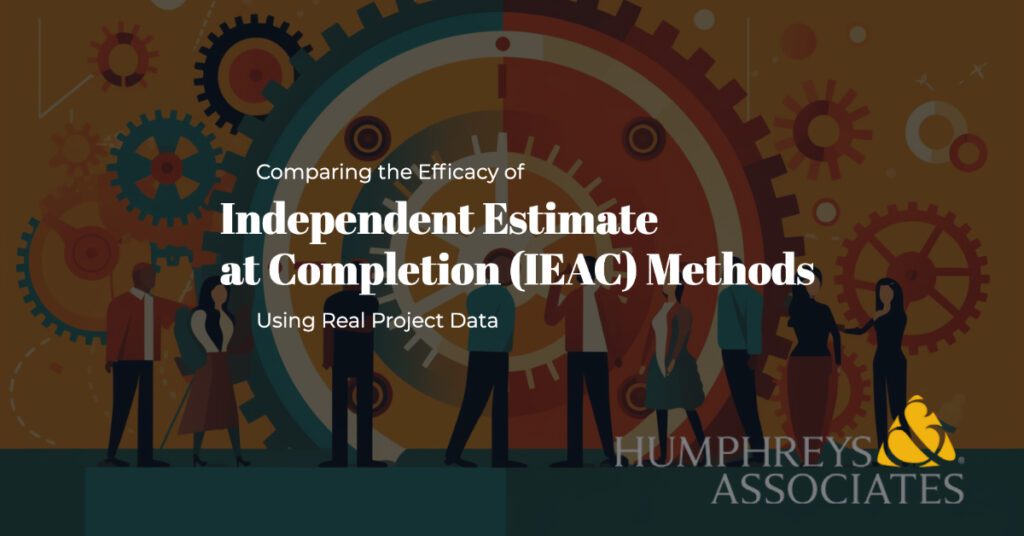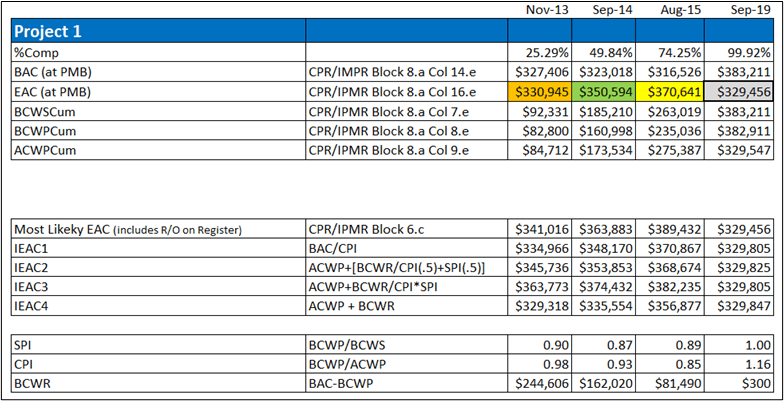Incorporating IMS Information Directly into Independent Estimate at Completion (IEAC) Formulas

“When you need to discuss the schedule, look at the schedule.”
– A Scheduler’s Lament
There are many existing formulas for calculating an Independent Estimate at Complete (IEAC) from earned value data. A recent study of a sample of projects found that the calculated IEACs analyzed at the 25%, 50%, and 75% complete points were not accurate when compared to the final actual cost of work performed (ACWP). The following table lists the thresholds used to assess the accuracy of the IEACs at the different complete points for the sample projects.
| Percent Complete | Accuracy Threshold |
|---|---|
| 25% | Within +/- 10% of final ACWP |
| 50% | Within +/- 7% of final ACWP |
| 75% | Within +/- 5% of final ACWP |
While working on that study of the accuracy of commonly applied IEAC formulas as well as on a small project as an analyst for a customer, the idea for using data directly from the integrated master schedule (IMS) in conjunction with the cost performance data to create a new IEAC formula emerged.
Using Data Directly from the IMS to Calculate an IEAC
It should be noted that none of the generally used IEAC formulas use data directly from the IMS. The IEAC formulas use data found in the cost performance portion of the earned value monthly reports to customers.
IMS data is only used indirectly in the IEAC formulas. When a task is started and progress updated, the earned value (the budgeted cost for work performed or BCWP) is developed from the progress reported. This is measured against the cost baseline (the budgeted cost for work scheduled or BCWS).
At the same time, in the IMS environment, the schedule analysts are calculating the Baseline Execution Index (BEI) for task completions/finishes. BEI (for finishes) measures how many of the tasks baselined to be completed by the cut-off date were completed. If all the tasks were done (BEI = 1), their value would have been earned. Of course, other tasks could have started, progressed, and maybe even finished. For this example, the Schedule Performance Index (SPI) calculated at that point (BCWP/BCWS) should be at least 1 and potentially higher. The SPI reflects the baseline value of completed tasks plus the in-process claimed baseline value. The in-process claimed value can be subjective in some cases.
The argument, if there were one, might be there is no need to try and include BEI or similar schedule measures in the IEAC formulas since they already include SPI.
However, there is a whole different and unique set of information coming from the IMS that is not currently used in the IEAC formulas. That information is what we chose to call “Duration Performance” and “Realism Ratio.” These are measures of the actual duration for completed tasks and the forecast duration for future tasks.
Calculating Duration Performance
The IMS data includes the baseline number of days assigned to each task as well as the actual number of days to complete each task. If a task is baselined to take 10 days (Baseline Duration = 10) and the task took 15 days to complete (Actual Duration = 15) then it is taking 150% of baseline to do the work.
This is similar to the Cost Performance Index (CPI) that uses the BCWP and the ACWP to determine how efficient the work performance has been. The formula BCWP/ACWP shows how the work accomplished compares to the cost of that work performed.
If we assume, for labor at least, that taking longer to complete a task often leads to costing more than baselined, we can use the Duration Performance to develop an IEAC.
To develop the Duration Performance, we would use the IMS from the month being analyzed to perform the following actions:
- Filter out all summary tasks and look only at real work tasks.
- Decide what to do with level of effort (LOE) – keep it or ignore it.
- Filter for all tasks that are completed (100% complete).
- Add up the baseline duration in days for all these completed tasks.
- Add up the actual duration days for these same completed tasks.
- Compare the actual duration days used to the baseline duration days.
An example would be:
- 100 completed tasks
- Total baseline days duration = 1,000
- Total actual days duration = 1,500
- Duration Performance = 1,000 / 1,500 = .67
One of the common IEAC formulas is the “SPI times CPI” that is calculated like this: ACWP + Budgeted Cost of Work Remaining (BCWR) / (CPI x SPI) where BCWR = Budget at Completion (BAC) – cumulative to date BCWP.
Now that we have a duration performance factor, we can develop a new IEAC. The Duration Performance IEAC would be done using the CPI from the same month as the IMS where ACWP + BCWR / (CPI x Duration Performance Index).
Using some actual data from a project for a single month we see:
- Duration Performance Index = .82
- BEI = .72
- CPI = .92
- SPI = .94 (significantly higher than the BEI)
- ACWP = $9.2M
- BCWR = $18.3M
- IEAC using standard formula with CPI x SPI = $9.2 + $18.3 / (.92 x .94) = $30.3M
- IEAC (Duration Performance) = $9.2 +$18.3 / (.92 x .82) = $33.5M
Assessing the Realism Ratio
When we look at the remaining tasks to be completed, we can use the Realism Ratio to assess how the future forecast durations compare to the performance so far.
The data needed are the baseline duration and the forecasted duration for all tasks that have not been started. This concept excludes in-process tasks. In our example from before, the data we created looked like this:
- 100 completed tasks
- Total baseline days duration = 1,000
- Total actual days duration = 1,500
- Duration Performance = 1,000 / 1,500 = .67
We would use the same IMS to do this:
- Filter out all summary tasks and look only at real work tasks.
- Decide what to do with LOE – keep it or ignore it.
- Filter for all tasks that are not started.
- Add up the baseline duration in days for all these tasks not started.
- Add up the forecasted duration days for these same tasks not started.
- Compare the forecasted duration days to the baseline duration days.
Let’s say there were 100 tasks not started. If the forecasted days were 1,000 and the baseline days were 1,000 that would yield 100%. When we did the example, the Duration Performance was .67. This means that performance to date was .67 but the future will be 100% or 1. You can see the disconnect. That disconnect we call the Realism Ratio (in this example, .67/1).
Data from the actual project for the same month as discussed earlier shows:
- Duration Performance = 122% of baseline
- Future Performance = .86 or 86% of baseline.
This means that the future durations are cut significantly.
We would use this data to develop a factor called a Realism Ratio (86/122 = .70) and that would be used to develop an IEAC using this formula: IEAC (Realism Ratio) = ACWP + BCWR / (CPI x Realism Ratio).
Using the same sample project data from above and adding in an assessment of the forecasted durations for the remaining work, we see:
- Duration Performance = .82
- BEI = .72
- CPI = .92
- SPI = .94 (significantly higher than the BEI)
- ACWP = $9.2M
- BCWR = $18.3M
- Realism Ratio = .70
- IEAC using standard formula with CPI x SPI = $9.2 + $18.3 / (.92 x .94) = $30.3M
- IEAC (Duration Performance) = $9.2 +$18.3 / (.92 x .82) = $33.5M
- IEAC (Realism Ratio) = $9.2 +$18.3 / (.92 x .70) = $37.6M
The project is not complete, so the final ACWP position is not known. There is a dramatic difference between the three IEACs. The difference between BEI and SPI indicates that in-process tasks and other factors such as LOE are potentially affecting SPI.
What can we learn from this sample project?
In this example, additional investigation is warranted. There are potential issues with the realism of the baseline and current schedule that are signaling a cost growth issue is likely to occur. Relying on just the time-phased cost data for IEAC calculations may not be sufficient to assess whether a contractor’s range of EACs included in their monthly cost performance reports are realistic. For more discussion, see the blog on Maintaining a Credible Estimate to Completion (EAC) and the blog on Using EVM Performance Metrics for Evaluating EACs.
Are there lurking cost growth surprises in your projects? You may want to consider revisiting your estimate to complete (ETC) and EAC process to verify there is an integrated assessment of the schedule and cost data to identify potential disconnects. H&A earned value consultants can provide an independent assessment of the quality of the data as well processes and procedures to help you verify your EACs are realistic. Call us today at (714) 685-1730.


